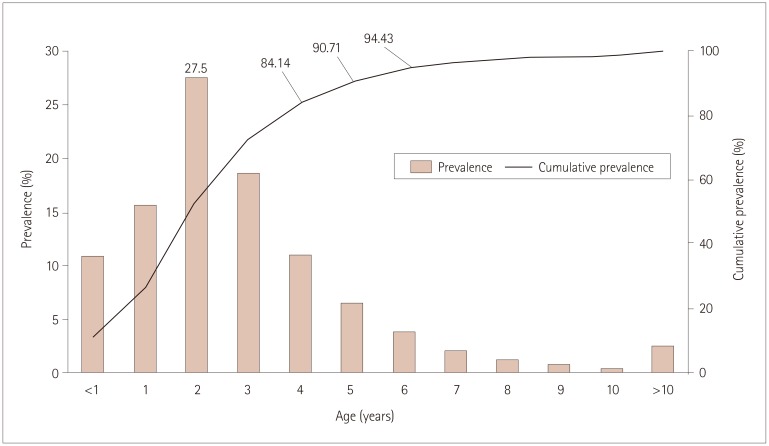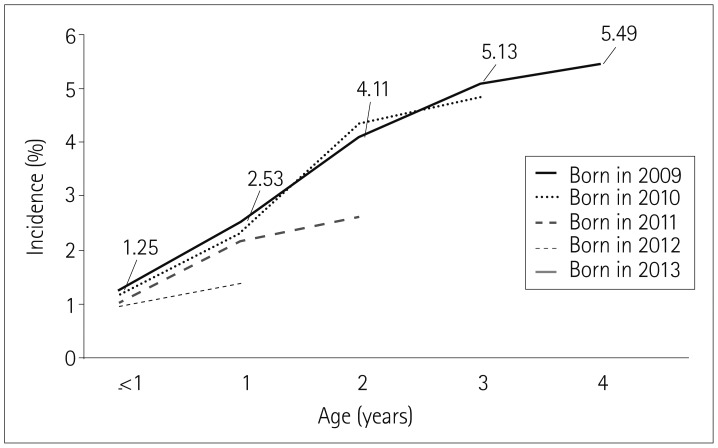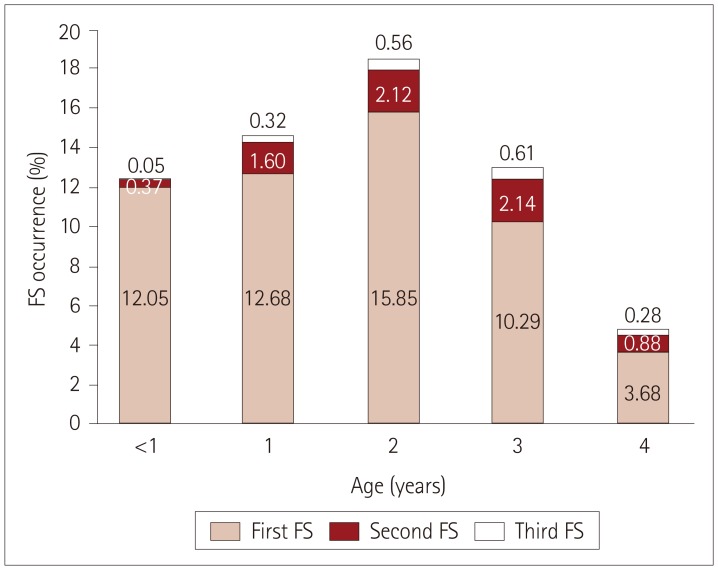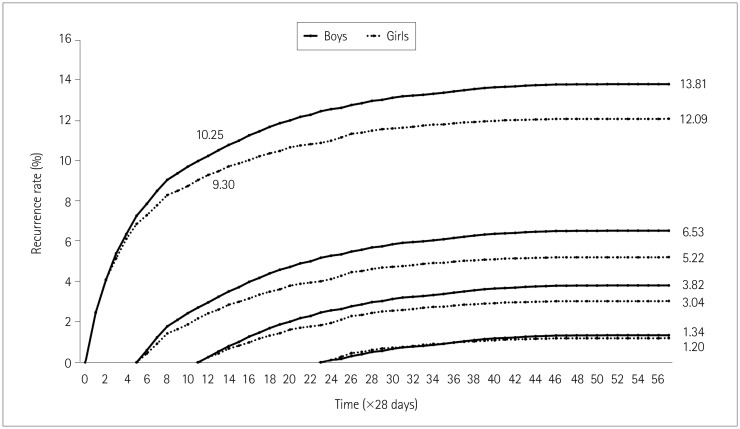J Clin Neurol.
2018 Jan;14(1):43-47. 10.3988/jcn.2018.14.1.43.
Prevalence, Incidence, and Recurrence of Febrile Seizures in Korean Children Based on National Registry Data
- Affiliations
-
- 1Department of Pediatrics, Korea University College of Medicine, Seoul, Korea. bleun@korea.ac.kr
- KMID: 2399598
- DOI: http://doi.org/10.3988/jcn.2018.14.1.43
Abstract
- BACKGROUND AND PURPOSE
Febrile seizures (FS) are the most common type of seizure during childhood, reportedly occurring in 2-5% of children aged 6 months to 5 years. However, there are no national data on the prevalence of FS in Korea. This study determined the prevalence, incidence, and recurrence rates of FS in Korean children using national registry data.
METHODS
The data were collected from the Korea National Health Insurance Review and Assessment Service for 2009-2013. Patients with febrile convulsion as their main diagnosis were enrolled. The overall prevalence of FS in more than 2 million children younger than 5 years was estimated, and the incidence and recurrence rates of FS were determined for children born in 2009.
RESULTS
The average prevalence of FS in children younger than 5 years based on hospital visit rates in Korea was 6.92% (7.67% for boys and 6.12% for girls). The prevalence peaked in the second to third years of life, at 27.51%. The incidence of FS in children younger than 5 years (mean 4.5 years) was 5.49% (5.89% for boys and 5.06% for girls). The risk of first FS was highest in the second year of life. The overall recurrence rate was 13.04% (13.81% for boys and 12.09% for girls), and a third episode of FS occurred in 3.35%.
CONCLUSIONS
Our study determined the overall prevalence of FS using data for the total population in Korea. The prevalence was comparable to that reported for other countries. Patients with three episodes of FS need to be monitored carefully.
Keyword
MeSH Terms
Figure
Cited by 1 articles
-
Occult bacteremia in children with simple febrile seizure in the post-pneumococcal conjugate vaccine era
Gwan Shik Yoon, Hyun Jung Chung, Young Hoon Byun, Min Jung Kim, Soo Hyun Park, So Hyun Paek, Ok Jun Kim, Jae Hyun Kwon
Pediatr Emerg Med J. 2021;8(2):51-56. doi: 10.22470/pemj.2021.00353.
Reference
-
1. Syndi Seinfeld D, Pellock JM. Recent research on febrile seizures: a review. J Neurol Neurophysiol. 2013; 4:19519. PMID: 25383238.
Article2. Kaputu Kalala, Mafuta Musalu E, Dubru JM, Leroy P, Tomat AM, Misson JP. [Epidemiology and characteristics of febrile seizures in children]. Rev Med Liege. 2013; 68:180–185. PMID: 23755708.3. Berg AT, Shinnar S, Shapiro ED, Salomon ME, Crain EF, Hauser WA. Risk factors for a first febrile seizure: a matched case-control study. Epilepsia. 1995; 36:334–341. PMID: 7541745.
Article4. Nelson KB, Ellenberg JH. Prognosis in children with febrile seizures. Pediatrics. 1978; 61:720–727. PMID: 662510.
Article5. Camfield P, Camfield C. Are febrile seizures an indication for intermittent benzodiazepine treatment, and if so, in which cases? Epileptic Disord. 2014; 16:S84–S88.
Article6. Mathai KV, Dunn DP, Kurland LT, Reeder FA. Convulsive disorders in the Mariana Islands. Epilepsia. 1968; 9:77–85. PMID: 5247004.
Article7. Tsuboi T, Okada S. Seasonal variation of febrile convulsion in Japan. Acta Neurol Scand. 1984; 69:285–292. PMID: 6464667.
Article8. Stafstrom CE. The incidence and prevalence of febrile seizures. In : Baram TZ, Shinnar S, editors. Febrile Seizures. San Diego: Academic Press;2002. p. 1–25.9. Kim HA, Kim S, Seo YI, Choi HJ, Seong SC, Song YW, et al. The epidemiology of total knee replacement in South Korea: national registry data. Rheumatology (Oxford). 2008; 47:88–91. PMID: 18077497.
Article10. Shinnar S, Berg AT, Moshe SL, Shinnar R. How long do new-onset seizures in children last? Ann Neurol. 2001; 49:659–664. PMID: 11357957.
Article11. Sidenvall R, Forsgren L, Blomquist HK, Heijbel J. A community-based prospective incidence study of epileptic seizures in children. Acta Paediatr. 1993; 82:60–65. PMID: 8453224.
Article12. Verity CM, Butler NR, Golding J. Febrile convulsions in a national cohort followed up from birth. II--Medical history and intellectual ability at 5 years of age. Br Med J (Clin Res Ed). 1985; 290:1311–1315.
Article13. Shinnar S, Glauser TA. Febrile seizures. J Child Neurol. 2002; 17(Suppl 1):S44–S52. PMID: 11918463.
Article14. Knudsen FU. Febrile seizures: treatment and prognosis. Epilepsia. 2000; 41:2–9.
Article15. Verity CM, Butler NR, Golding J. Febrile convulsions in a national cohort followed up from birth I--Prevalence and recurrence in the first five years of life. Br Med J (Clin Res Ed). 1985; 290:1307–1310.
Article
- Full Text Links
- Actions
-
Cited
- CITED
-
- Close
- Share
- Similar articles
-
- Early postictal electroencephalography and correlation with clinical findings in children with febrile seizures
- The Effectiveness of a Low-dose Oral Diazepam Treatment to Prevent Recurrence of Febrile Seizures
- Selection of High Risk Group According to Risk Factors of Recurrent Febrile Seizures
- A comparison of provoked seizures and febrile seizures associated with minor infections
- Relationship between Recurrence in Febrile Seizures and Serum Zinc Levels





